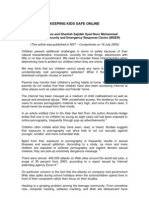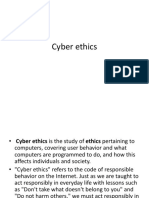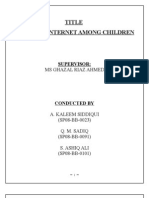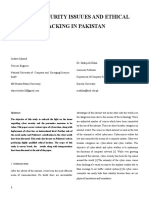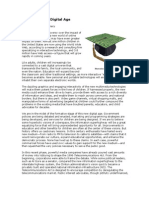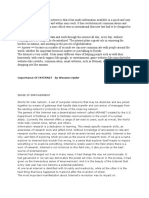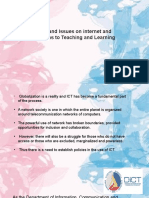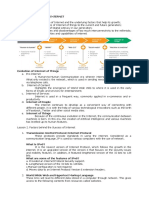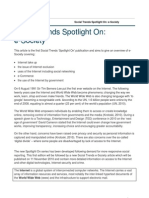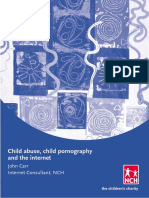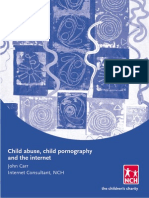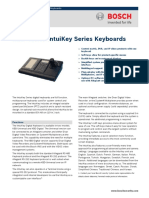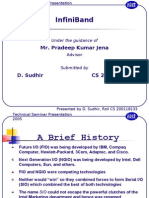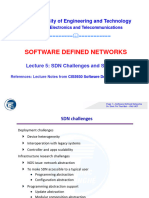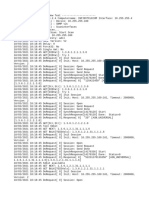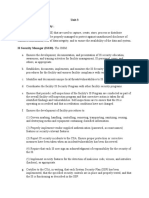Protecting Children in Cyberspace
Nauman Munir Afzal
House # 25, Lane #1,
Aziz Bhatti Road,
Lahore Cantt
nmafzal@gmail.com
Cell: 0333-5176201
Abstract.
Internet is in a constant state of growth and change. New technologies mean new
services and hence it is always in a state of evolution. Internet is neutral and can
be used by anyone for any purpose. There area lot of ills and threats thriving in
cyberspace and children are susceptible to these ills. These are covered in some
detail here along with a brief analysis. Based on the analysis some worth
recommendations have also been made. These recommendations if considered for
adoption can help control the menace of child exploitation in Cyberspace.
1. Introduction.
The Internet is strange in many ways. Since its birth it has been
growing at a phenomenal rate. 100 million websites and 1.5 billion
internet users later this medium is growing and still strong. Few
would have imagined its potential and power just a decade ago and
fewer still would have predicted the way it is today. Since its
inception it has been used for a myriad purposes, there is business,
the daily E-mail, news, recreation, education, entertainment, social
purposes, research and the inevitable chat to count a few. Each day a
new use, a new technology and a new purpose is discovered. One
thing is for sure now, there is no escaping the Internet, that is, it is
now inevitable. Cyberspace is difficult to control and dominate,
today. As the number of its netizens comprising young, old, poor,
rich, simple, troublesome, black, white and all increase its making
its own set of rules and is akin to controlling an underworld, that is
by all means huge and constantly growing. Human behavior, habits
and actions are unpredictable and this very feature makes the
cyberspace hazardous. Add to this the fact that in cyberspace
everybody can be somebody and a nobody all at the same time and
we have a very complicated situation. There are children, adults,
professionals, students, hobbyists and business people and then there
are people with fake identities, perverted ideas, and assumed
characters.
1
�The Internet is addictive because it is always there and surprisingly
there is something for everybody in it. These features make it
attractive for all, and children are no exception to it. It is their
curiosity and urge to learn that drives them to ride the Information
Superhighway. The vast and endless amount of information
available on the Net is a wonderful feature, and hence the attraction.
This attraction does not end here, for the Net is prone to all types of
threats. Threats from predators, threat from unwanted data, threat
from pornography, lurkers, unsolicited e-mails etc. Children in
young and tender ages are susceptible to all such hazards and
uncontrolled use of the Net can lead to circumstances and occasions
that are unwanted and in some cases ugly. Besides control and
monitoring, there have to be in place laws, rules, regulations,
policies and guidelines so that the menace can be addressed at all
levels instead of leaving it o the parents to guard the children. It has
to be a systematic process covering various tiers, so that slips at one
end can be covered at another so that the issue addressed in totality.
2. Pakistan’s ICT Statistics.
Internet was first introduced in Pakistan around the year 1995-96.
Over the years its usage has increased and so have its users. After
the Telecom de-regulation Act of 2003 both Internet as well mobile
growth mushroomed in the country. Now with the introduction of
newer technologies like broadband and WiMAX its penetration has
further increased. The tele-density has in Pakistan has increased
from 45.04 in 2006-07 to 58.8 in 2007-08 [1]. Pakistan’s tele-density
growth during the last five years is shown in Fig 1 and the important
ICT related statistics of Pakistan for the year 2008 are as shown in
Table 1.
2
� Figure 1. Tele-density in Pakistan. (Source: Pakistan Telecom
Authority, Annual report. 2008)
Statistic Unit Remarks
No of PCs / 100 0.41
inhabitants
No of ISPs 50
No of Internet 3.7 Million
Connections
No of Internet Users 17 Million
No of Cyber cafes/Tele 5
centers /10,000
inhabitants
Tele-density 58.8
No of PCOs 449,121
No of Mobile Phone 88,019,812
users
No of Internet connected 3002
cities
Table 1: Pakistan’s ICT statistics for 2007-08 (Sources: ISPAK,
PTA Annual report 2008, Ministry of Finance Economic Survey
2008, ICT Profile Pakistan: Asia-Pacific Development Information
Program, Pakistan ICT Indicators: Statistics Division Government of
Pakistan )
3
�From Table 1 it is evident that Internet penetration has increased
considerably in Pakistan during the last few years. According
Finance Ministry of Pakistan, Economic Survey 2008-09 [2] the
number of Internet connections in Pakistan is 3.7 million and
according to ITU the numbers of Internet users in Pakistan is around
17.5 million [3]. The estimated population of Pakistan is around 160
million [4]. The literacy rate stands at around 40% [4]. It is
important that the Internet is accessed by the literate people. In fact
it would not be incorrect to say that illiterate population of Pakistan
would be largely ignorant and uninterested in accessing the Internet.
So out of the 60 million literates around 17.5 million have access to
the Internet and that makes it around 10% of the total population.
The total number of students enrolled in schools (Primary to
Secondary) in 2005-06 is 31.5 million [5]. So it we can safely
assume that a sizeable population of children comprise the total 17.5
million users. A number of factors have contributed to this increase
and jump in numbers. These are summarized as under:
2.1 Decline in price of Computer Hardware.
There has been a sharp decline in the price of computer
hardware during the last couple of years. This and the import
of used and refurbished computers from abroad has resulted in
flooding of local markets by various brands of computers and
their related products.
2.2 Availability of Pirated Software.
The average Pakistani is unaware about software copy right
issues. The local markets are full of any and all brands of
software at dirt cheap prices; this has greatly facilitated the
populace.
2.3 Mushrooming of Internet/Cybercafés.
There has been a huge increase in the number of Internet cafes
all around the country. Almost every street and corner of any
locality now has a cybercafé. The local unemployed youth
found it to be a profitable business to run such cafes and hence
the growth. Users are charged by the hour at most cafes which
are generally thronged by the students and all those who have
no access to PCs and/or telephone lines.
4
�2.4 Reduction in IPLC Charges.
There has been a significant decrease in the IPLC charges by
PTCL during the last few years. The end result of this all was
the availability of cheap Internet facilities to the end user. In
this regard efforts of ISPAK and previous Governments are
laudable [6].
2.5 Increase in Tele-density.
The telecom industry in Pakistan has shown huge growth
during the last couple of years as is evident form the tele-
density figures. Although this also includes the figures of
Mobile phones, but nevertheless the availability of Telephones
and Customer oriented policies by PTCL has greatly facilitated
the end users.
2.6 Availability of Internet access on Landline numbers by
Telcos.
The single step by Telcos like PTCL and SCO has resulted in
the provision of cheap Internet to all subscribers of landline
phone holders. Now all landline numbers come pre-configured
for dialup access and hence facilitate the users.
2.7 Availability of Packet Data Services.
Today all mobile operators in Pakistan are offering packet data
services at competitive rates. Most offer EDGE and all offer
GPRS. Although 3G is still a dream come true for the average
Pakistani, still Packet data services have made it easy for
owners of Packet Data enabled devices to access Internet on
the go.
3. Defining the Threat.
The Internet is an amalgamation of various technologies. These
when put together define the fabric of the Net. The technologies in
turn make available various services for the users. Services in turn
have various hazards depending on the use and abuse by the users.
There are various types of threats that anyone can face, and children
are specially susceptible to these threats. It is important to
5
�understand that nowadays Internet can be accessed by not only PCs,
but the availability of other gadgets like mobile phones, PDAs, and
smart phones make it easy to access the Net “on the go”. This makes
the threat even larger as now anyone with such a device can visit
cyberspace at will. The following are various threats that children
specially face in the cyberspace:
3.1 Pornography.
Pornography is a big threat to anyone on the Internet and
children are no exception to it. According to a report on
Internet Pornography Statistics the total global pornography
revenue for 2006 was around $97.06 Billion [7]. The total
number of pornographic websites is estimated to be 4.2 million
[7]. The availability of free porn at will to the netizens is a big
menace. In the recent past there have been efforts at containing
this threat internationally as well at national level. The
suggestion for having a .xxx TLD name is one such example of
the former case, and the blocking of offensive websites by
PTCL an example of the latter. Interestingly, Pakistan ranks at
the top position in the worldwide search requests for the
keyword “sex” [7]. A survey conducted found that 80% of the
children in Pakistan who went to Cyber cafes had accessed
pornographic material [8]. This simply means that all is not
well, if these statistics are anything to go by.
3.2 Child Pornography.
Young children who access the Internet by any means are
exposed to threat of Child pornography. This is yet another
danger. Pedophiles are always on the lookout for young
children, both boys and girls who lure them in to exposing
them or may even expose themselves to young children with
the aim of trapping them for sexual purposes. There are an
estimated 100,000 websites offering child pornographic
content, illegally [7]. The same report states that the daily
Gnutella requests for “child pornography” are approximately
116,000.
3.3 Sex Crimes and Sexual Abuse.
The Internet is largely a neutral medium which can be used by
anybody for any purpose at will. Sex crimes and sexual abuse
6
� is another such risk. An example in this case is the Rawalpindi
Internet Café scandal which was unearthed in the year 2003.
Young unsuspecting couples, mostly teens were caught on tape
during their unsuspecting moments and were later blackmailed
by the café owners with threats of leaking their misdeeds. The
very case shook the country and brought to light the
happenings of this case.
3.4 Cyber Bullying.
Cyber bullying may include stalking, harassing or annoying
the users or children by any means such as offensive remarks,
use of strong language, sending offensive pictures or material.
A child that is not aware of such language or behavior may
become agitated and this can have adverse affects on his/her
personality,
3.5 Money Swindlers and Scams.
The Internet is bursting with money swindlers, con artists, get
rich schemes and many such money related scams. Unaware
children may fall prey to such people or parties and loose
money in the process.
3.6 The Chat Rooms Menace.
The presence of chat rooms is perhaps the most dangerous of
all such threats. This is place where people with assumed
identities and fake names lurk and thrive. There are millions of
chat rooms of various categories on the Internet. Policing such
a large number of rooms is not easy and here technology can
play an important role.
3.7 Health Issues.
The repeated and prolonged use of computers, gaming
consoles and handheld devices can result in serious health
related problems. Repetitive Stress Injury, addiction to games,
isolation from the real world and sleeplessness are some of
these. Although this is not directly related to cyberspace but is
important enough to notice as it can have ill affects on the
child’s health.
7
�3.8 Online Gaming.
Modern games whether played on PCs, consoles or gaming
devices are addictive and hence worth noticing. These games
may affect young minds in a negative manner as most of the
games involve fantasy world, where violence and carnage
takes place at an unprecedented scale. PCs and gaming
consoles host games that have online access and hence may be
accessed by children as a result of which they may fall prey to
harmful material.
3.9 Spam or Unsolicited E-mail.
Spam or unsolicited e-mail is another dark area. According to a
study an estimated 12.4 billion spam e-mails are sent daily out
of these 19% fall in the adult category [9]. These e-mails may
include invitations or advertisements to view pornographic
material and hence may prove harmful for children. Although
spam filters being offered by free e-mail services are quite
advanced, nevertheless the possibility of getting spam is real.
3.10 Social Networking Websites.
There are millions of social networking and dating websites on
the Internet. A large number of these websites are for adults
only and gaining access to these is not difficult as most boast a
simple process of making an online profile. Young children
often give out their personal details on the websites including
photographs, which may at times prove harmful. This fad has
taken the younger generation by storm and having an online
presence on Facebook or Orkut is considered cool and not
having one unfashionable.
3.11 Mobile Phone Issues.
As stated earlier mobile phones falling in the 2.5 to 3G
category can be used for fast Internet access. Moreover, all
mobile operators in Pakistan are offering GPRS and EDGE at
competitive rates and a new connection in most cases comes
with such services by default. The following issues related to
mobile phones need serious review:
8
�3.11.1 Internet Access via Mobile-phones, Smart-phones
and PDAs.
There has to be a procedure for disallowing access to
adult sites when accessed from mobile phones. This
is important since children with such devices are
prone to the ills of the Internet.
3.11.2 Location Identity Issues.
Some mobile operators offer location identity
ascertaining facilities to subscribers. Although this is
a good utility of used in the right manner, but can
also have adverse affects if misused and hence merits
attention.
3.11.3 Subscription Services.
Mobile phone users may receive adverts on
subscription services inviting users to subscribe for
various services. This happens through text messages.
There is also sms marketing software which invades a
user’s privacy. Unsolicited sms marketing is now
gaining popularity and therefore needs attention.
3.11.4 Premium Rate Services.
Premium rate services provide users with different
options for entertainment purposes e.g. Group chat
(voice), one-to-one chat (voice), songs etc at slightly
higher rates than a normal call. Such services are
available for mobile as well as landline users. Anyone
with a mobile or a landline phone can dial the
required number and start talking to strangers
regardless of his/her age.
3.11.5 Anonymous Text Chat.
Anonymous text chat is being offered by mobile
operators to the users from within the Sim Tool Kit
9
� and mobile users can simply start chatting away using
their GSM connections.
3.11.6 The Inevitable MMS.
MMS is a service which allows users to send
graphics, pictures or even movie/sound clips to other
mobile users at very nominal rates using modern
mobile phones. Children have been known to either
get pornographic material from the Internet or to
produce it themselves and then share it among
themselves using mobile phones [8]. Most new
mobile phone connections come pre-configured with
MMS.
3.11.7 Anonymous Calls/Text Messages.
The phenomenon of receiving anonymous calls and
text messages is not new. There is only one mobile
operator in Pakistan that has introduced a service of
blocking unwanted calls form undesired numbers.
Although most operators do recognize this menace
and have quite friendly procedures for reporting such
instances, still the facility of blocking an unwanted
caller is good if used in the proper way.
4. Pakistan’s Child Related Cybercrimes Statistics.
Sadly the statistics related to child related cybercrimes are non-
existent in Pakistan. There is a serious need to delve in to this area.
In the absence of credible data not much can be predicted or
planned.
5. Local Laws for protection of Children in
Cyberspace.
On 31st Dec 2007 Pakistan approved the Prevention of Electronic
Crimes Ordinance 2007. In this Ordinance 17 different types of
cybercrimes have been stated as punishable. A Police Cybercrimes
10
�Department has also been established at national level. This unit
basically hires experts from the market for checking Internet crimes
related mostly to financial or terrorism issues. There is no law or
ordinance exclusively for the children. However, Chapter II of the
Ordinance does specify a few crimes that can be applied to anyone
in general, like Electronic fraud, Cyber stalking (including
communicating via lewd messages or pictures etc) and spamming
[10]. The Ordinance can be amended to include crimes specific to
children in Cyberspace.
6. Laws/Measures for Protection of Children in
Cyberspace in various Countries.
Developed countries the world over took notice of this menace long
time back and hence enacted laws or measures for its prevention.
Sadly, in Pakistan the issue has not come to limelight. Although
people are generally aware of the menace but in the absence of
statistics, laws and policing the issue has largely been ignored.
Following are some of the steps taken in various countries for
prevention children in Cyberspace:
6.1 Child Online Protection Act 1998.
This law was passed in the US in 1998 with aim of protecting
children from viewing harmful material [11]. The US federal
courts objected to it as according to them it is against the
concept of free speech and hence this law was not enforced.
However, it is important to note that the US Government was
alive to this situation back then.
6.2 International Telecommunication Union (ITU).
ITU has launched a new initiative on prevention of children in
cyberspace called as Child Online Protection Initiative in 2008
[12]. This basically aims at taking certain steps to protect
children in Cyberspace. The ITU recognized that such
programs and initiatives are already working in developed
countries but in developing countries are either very less or
non existent.
11
�6.3 Australian Federal Police (AFP).
The AFP has a dedicated Child Protection Operations (CPO)
team that is carrying out investigative and coordination
activities for the prevention of children online [13]. This body
collaborates with national as well as international stake holders
like Interpol, NGOs, ISPs, hosting service providers and even
the general public. The unit provides information on Internet
safety, allows public to share details or report matters related
to children who they believe are at risk from someone or have
been abused.
6.4 Child Exploitation and Online Protection Center (CEOP).
This is an initiative of the UK Police with similar aims to that
of AFP CPO [14]. The organization provides support to
parents, teachers and children by spreading awareness on
Internet related ills. It also aims at gathering intelligence about
such issues, bringing criminals to book. It also collaborates
with International agencies for these purposes.
6.5 Virtual Global Task Force (VGT).
Virtual Global task Force comprises of Police personnel from
around the world with the purpose of countering online child
abuse [15]. Both the CEOP and AFP CPO collaborate to bring
criminals to justice besides providing support and help to
adults as well as children for protecting themselves in
cyberspace,
7. Important Conclusions.
Before giving recommendations a brief analysis of the important
issues is presented as under:
7.1 ICT related statistics in Pakistan have registered a
sharp increase. This trend is expected to increase
more in the coming years.
12
� 7.2 Various factors have contributed to the increase in
number of Internet users in Pakistan.
7.3 Out of the 17 million Internet users in Pakistan a
sizeable population is that of the children who are at
risk of exploitation and abuse due to various threats.
7.4 There are a number of threats that the children may
face over the Internet or through use of mobile
phones which need to be countered.
7.5 There is a serious dearth of statistics regarding child
related cybercrimes in Pakistan in the absence of
studies and surveys that can explain this trend in our
society.
7.6 There is absence of laws on the issue of child
protection in cyberspace in Pakistan.
7.7 The general level of awareness of the public on this
issue is not very good.
7.8 The Prevention of Electronic Crimes Ordinance does
not cater for the important aspect of protection of
children online.
7.9 Developed countries have taken a lead in addressing
this issue however; developing countries like
Pakistan are required to take necessary steps in this
direction.
7.10 A multi-tiered approach is required to protect
children in cyberspace.
8. Recommendations.
Following recommendations are offered for the Government of
Pakistan:
8.1 Involvement of Stakeholders.
13
� The Government needs to take all stakeholders on board before
tackling this issue. This includes ISPs, ISPAK, Ministry of
Education, Ministry of IT and Telecom, PTA, Mobile
Operators, NGOs, the general public and Police department.
8.2 Collection of data/Statistics.
It is important to collect data related to children related
cybercrimes in Pakistan so that the exact picture can be
ascertained. In this regard surveys and studies need to be
carried out by the Government as well as non government
bodies.
8.3 Policy/Laws on Protection of Children in Cyberspace.
There is a dire need of having a law on the protection of
children in cyberspace. This needs to be discussed in the
National assembly before ratification by the concerned bodies.
8.4 Awareness campaigns.
A wave of massive awareness campaigns has to be started with
the aim of educating and making aware the parents, users,
children and teachers regarding the vulnerability of children in
cyberspace. This could include the following:
8.4.1 Use of Media.
Spread the word around through advertisements in
Papers, FM radio, TV and Internet.
8.4.2 Awareness Programs.
Discussions and programs on public and/or private media
channels need to be arranged for making the general
public aware about this issue.
8.4.3 Workshops and Campaigns.
Workshops and awareness campaigns should be held at
schools, colleges and institutions inviting the students,
faculty as well as parents. NGOs can play an important
role here.
14
�8.5 Education.
There is a need to make the topic of cyber related threats and
crimes a part of the children’s syllabus. Most of the schools
today are teaching Computer Science as a subject from
primary level, therefore, the same syllabus can be modified
and a chapter could be included for educating the children on
the ills prevailing in cyberspace. Teachers also need to be
educated on this issue so that they are able to guide the
students.
8.6 Role of ISPs.
The ISPs and ISPAK can play a very important role here. The
following are some of the doable recommendations for ISPs:
8.6.1 Children Package.
A children package can be exclusively launched by ISPs.
This can include blocking of websites at the local level so
as to protect the children.
8.6.2 Startup Messages.
The default homepage can be set to display a message
warning the user to use the web safely to his/her
advantage. This could display important information
about the issue under discussion.
8.6.3 Instructions on buying a new connection.
Detailed instructions for the users and parents regarding
safe web browsing, net etiquettes and various hazards of
Internet.
8.7 Mobile Operators.
Mobile operators should also contribute their share. Some
worthy recommendations are:
8.7.1 Children Package.
15
� To date there is only one operator in Pakistan that has
launched a package for use by the children only. This
includes options for making calls only to specified
numbers and/or receiving text/calls from specified
numbers. All Mobile operators should launch packages
solely for children from 7 to 18 years of age. Operators
should be told to sell new connections to minors only if
accompanied by parents.
8.7.2 VAS and other services.
The services mentioned in section 3.11 should not be
activated by default in fact the user should get them
activated only if required. In order to discourage the use
of such services users should be asked to visit the
respective Customer Services Centers for getting these
services activated. The package tailored for children
should either not include any of the following or it may
be activated with the consent of parents:
8.7.2.1 Internet via GPRS/EDGE.
8.7.2.2 Location Identity.
8.7.2.3 Subscription Services.
8.7.2.4 Premium Rate Services.
8.7.2.5 Anonymous Chat.
8.7.2.6 MMS.
8.7.3 User Awareness.
The mobile operators should also make aware the parents
and adults about the issue under discussion via leaflets,
text messages and seminars.
8.8 Involvement of Police.
The Cybercrimes division of the Police Department should be
asked to include protection of children in their mandate to
tackle this problem. Necessary amendments in Police laws
may be required for this purpose. They should also collaborate
with International agencies like Interpol and VGTF since the
Internet transcends physical boundaries and online crimes can
be committed regardless of one’s physical presence at the
crime scene.
16
�8.9 Use of Right Technology.
Following steps may be taken for introducing technology
related solutions to these problems:
8.9.1 Filtering Software.
Use of filtering software should be promoted for children
accessing the Internet. Educational institutions,
cybercafés and normal users should also be asked to use
such software for making web usage safe for kids. Net
Nanny, Cyber Sitter and Cyber Patrol are a few examples
in this case.
8.9.2 Web Safe Browsers.
There is a plethora of web safe browsers available in the
market today [16]. These can be made use of.
Alternatively the Government can get a web safe browser
developed for meeting needs of the local market. All
stakeholders should promote use of such applications in
their advertisements or awareness programs.
8.9.3 Open Source Solutions.
The web is littered with Open source solutions targeted
for various audiences and tailored to meets specific needs
of organizations or individuals. Sourceforge.net [17] is
one such website where projects developed by
individuals or groups are uploaded for free usage by
everyone and anyone. These could be made use of or the
government can also get a Linux distro developed
specifically for the children. This could also reduce our
reliance on pirated software and at the same time provide
cheap home made solutions to the public.
8.10 Reporting Procedure.
A dedicated website should be made for reporting all such
crimes committed against children in cyberspace. This could
include general information, education and awareness lectures
on child protection, links to important websites, a procedure
for filing complaints online, via helpline or offline. The
17
� website should give a one stop solution on the topic under
discussion.
8.11 Review of Policy and other Issues.
Upon successful completion of this project a time limit should
be set by the Government to review the policies, laws and or
various steps taken. This would be useful because the web is
always changing and in a state of evolution, hence periodic
reviews of these issues can be fruitful.
8.12 Role of NGOs.
NGOs can play a very important role by carrying out surveys,
collecting data, spreading the word around, helping in policy
formulation and user education etc.
8.13 Collaboration with International Agencies.
Collaboration with International agencies like Interpol and
Virtual Global Taskforce for checking such crimes should be
done. This will also help in sharing valuable information and
statistics besides tracking wanted criminals. A similar
procedure has been adopted by the APF and CEOP as
discussed earlier.
8.14 Monitoring of Cybercafés.
Cybercafés need to be registered with Government. In fact it
would not be a bad idea to make it mandatory for anyone to
apply for a license to start a Cybercafé. This will ensure that
such establishments do not act as dens of pornography.
Necessary laws and policies in this regard can be enact out by
the Government.
9. Conclusion.
The Internet is here to stay and it is up to us how we use or abuse it.
Free speech pundits and advocates shun the notion of blocking
offensive websites as according to them it is against the principles
and ideas of free speech. The responsibility therefore, now lies on
the users and those who are being affected by its ills. Hence it is the
18
�user end that needs to be brought on board. Interestingly, this
challenge is not there for a few people, it is for everyone. Our
children are our future protecting them is our responsibility, as is
educating them or taking care of them. We are already late and the
time is now to make a start so that minimal damage is done.
19
�References
1. Pakistan Telecom Authority: Chapter 1 ‘Pakistan Economy’, Annual Report,
2008.
2. Ministry of Finance: Chapter 13, Economic Survey 2008-09.
3. International Telecommunication Union (ITU), www.itu.int , visited on 16
Apr, 2009.
4. Statistics Division, Ministry of Economic Affairs Government of Pakistan,
www.statpak.gov.pk , visited on 16 Apr, 2009.
5. Ministry of Education, Pakistan Education Statistics 2005-06,
www.moe.gov.pk , visited on 16 Apr, 09.
6. ISPAK Achievements: www.ispak.com.pk , visited on 16 Apr, 2009.
7. Internet pornography Statistics by Jerry Ropelato: www.toptenreviews.com ,
www.familysafemedia.com , visited on 15 Apr, 1009.
8. CWIN Nepal: Concept Paper, Protecting Children Online in Nepal - page 4;
CWIN Campaign of Protecting Children Online, www.cwin.org.np , visited
on 16 Apr, 2009.
9. Spam Statistics 2006; www.toptenreviews.com , visited on 16 Apr, 2009.
10. Ordinance No LXXII of 2007: Federal Investigation Agency Government of
Pakistan , Chapter II, www.fia.gov.pk , visited on 16 Apr, 2009.
11. COPA Commission , www.copacommisssion.org , visited on 18 Apr, 2009.
12. International Telecommunication Union (ITU), www.itu.int , visited on 18
Apr, 2009.
13. Australian Federal Police Child Protection Operations, www.afp.gov.au ,
visited on 18 Apr, 2009.
14. Child Exploitation and Online Protection Center (CEOP) , www.ceop.gov.uk,
visited on 19 Apr, 2009.
15. Virtual Global Task Force (VGTF), www.virtualglobaltaskforce.com , visited
on 19 Apr, 2009.
16. www.mykidsbrowser.com , www.kid-surf.com , visited on 19 Apr, 2009.
17. www.Sourceforge.net , visited on 19 Apr, 2009.
20
